Earlier last week, the BaBar Collaboration met at the SLAC National Accelerator Laboratory for its autumn meeting. Over four days, we discussed a great variety of physics (during over 100 parallel session talks), learned about the process of preserving the BaBar data for future researchers, and even celebrated our 400th published paper. In addition to these activities, we bid farewell to some long-time pillars of the BaBar community, as they move on to greater things, and we welcomed new members: young students and post-docs who came to the meeting fresh from the BaBar Analysis School the week before.
I attended the meeting not only to present some recent research activities, but to present my case for SMU membership in the collaboration. This case has been built up, in consultation with leadership in the collaboration, over the course of the last two months. It is with tremendous pleasure that I report that the case for membership was enthusiastically received, and SMU is now a new institutional member of the BaBar collaboration.
My participation is focused largely on contributions to the physics efforts of the collaboration: research, review, and publication. My goal is to also contribute simulated data, produced at SMU and distributed to the collaboration; this effort is already well underway and nearing complete success. Having established these milestones, my attention will be turning back to contributing to ATLAS through operational work. I’ll be at CERN in December, training for these efforts and learning from my experienced ATLAS colleagues. There are two blocks in my life right now, and I feel like a new kid on both of them.
While I have been a member of the BaBar Collaboration since 2000, I have always been so under the auspices of an established institution. Bringing a new institution into the collaboration is a novel experience for me, exciting and full of opportunity. I envision significant contributions being made by SMU undergraduates to the BaBar research effort. I see BaBar data serving as a direct means to engage students in independent research, to teach them modern research techniques, and to communicate the work and knowledge of particle physics. I see the immense dataset, in conjunction with the coming data from ATLAS, teaching us about all aspects of new physical phenomena: their properties visible only at the highest energies and their subtle effects visible only with the best precision, the most data. I see opportunity for SMU, and I am happy to be leading this effort.

